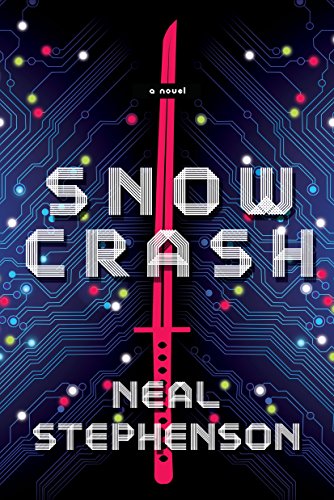To preface, I decided to change my rating system because I realized that a single number isn’t really a useful metric for rating a book. I read generally for three reasons: for enjoyment, to explore interesting concepts, and experience different perspectives or life paths I hadn’t considered before. So I decided that a new rating system that averages the individual scores in these categories would give me a more holistic metric of what I thought of the book.
Snow Crash was without a doubt one of the most fun books I’ve ever read, partly because I’m unable to properly categorize it. It fits into sci-fi, sure, but the best description I can come up with is that it is cyberpunk-dystopian-historical-satire novel. It’s brilliantly funny, narratively tight, and conceptually intriguing. The last book I read that fit into the cyberpunk genre was Neuromancer by William Gibson, and I really liked that story particularly for the world building and the concepts, but Snow Crash blew that away with in terms of pure enjoyment for it’s absurdist satirical take on a future cyberpunk dystopia.
Snow Crash is set in Los Angeles in the early to mid 21st century, following the fracture of most of the United States due to deteriorating economic conditions such as hyperinflation. Some of the “Fed” still exists, but people prefer to live in independent franchise-based neighborhoods and cities such as Mr. Lee’s Greater Hong Kong. It’s like a Libertarians wet dream of free enterprise, where all of the world’s inconveniences seem to be solved by outlandish entrepreneurial tech created by competing companies. For example, one of the main characters, a fifteen year old skater punk who goes by Y.T., keeps on hand devices like an electronic magnetic harpoon for latching onto cars as she she skates through traffic and a can of Liquid Knuckles to knock out anyone who wants to mess with her. Security is largely handled by private companies like the spun-off US military franchises General Jim’s Defense Systems and Admiral Bob’s National Security. The Sicilian Mafia and other gangs have greatly expanded their influence, owning wide swathes of territory and a monopoly over the pizza delivery business. The CIA and the Library of Congress merged and put out a stock offering, and are now in the business of buying and selling information to whoever wants it. Hackers and programmers like the main character Hiro Protagonist (yes, that is his name) spend much of their time in the Metaverse, a massive three dimensional virtual world that is the backbone of much of the modern world.
Stephenson deftly makes the world both absolutely ridiculous but also not completely unbelievable, and the little absurdist moments of satirical world-building add just the right amount of humor to occasionally put you in stitches without this book being overtly a comedy. The main characters are fun and perfectly fit the story, but they aren’t interesting character studies. They’re more a collection of classic protagonist tropes, but in this world it’s exactly what is necessary. The world building is nuanced and incredibly entertaining, and Stephenson does a great job of giving you just slivers of the history of this insane world without explaining everything. Like I mentioned earlier, this was one of the most fun books I’ve ever read, and would absolutely recommend.
--Luke Melander

